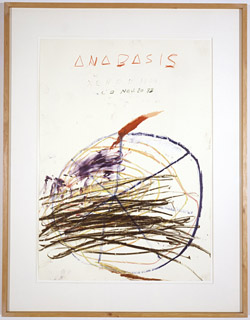The American painter Cy Twombly, close contemporary of Robert Rauschenberg and Jasper Johns, has been slow to achieve celebrity and is still little known outside that relatively small circle of people who take a serious interest in contemporary art. Yet his pictures regularly sell for millions of dollars and he is routinely referred to, in the encomia of his more vocal supporters, as one of the greatest living painters.
Born in 1928, in Lexington, Virginia, he emigrated to Italy in 1957, just as the other leading members of his artistic generation were beginning to achieve fame and fortune in their native America. The fact that he transplanted himself from New York at almost the precise moment when American artists and their dealers had established that city as the imperium of world art partly explains why his reputation has been so long in the making –– and it also helps to account for the peculiar esteem in which he is now held. Twombly is an erudite southern exquisite who was lured to the old world by the seductive richness of its history. His work often seems possessed by dreams of the past. It is full of references to classical mythology, to the gods and goddesses of the Greek pantheon, and shot through with an eclectic dilettante’s love of faded textures: the surfaces of his pictures often resemble crumbling, graffitied walls, redolent with the sense of their own, battered history. Yet Twombly’s work also speaks a pictorial language of slashing marks and sudden, improvised bursts of colour which is plainly inherited from the Abstract Expressionists, in whose shadow his generation of American painters grew up. His eulogists admire him because they see in his work a synthesis of European traditions and American high modernism. His oeuvre is seen as a kind of...

Cy Twombly: Works on Paper, at the Serpentine Gallery 2004
25-04-2004

